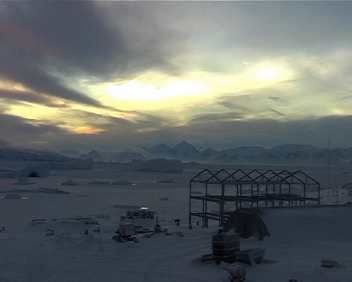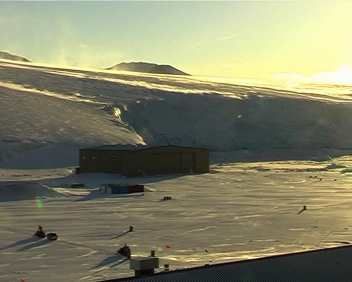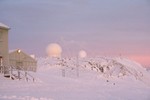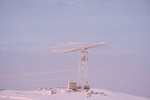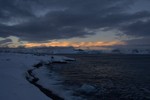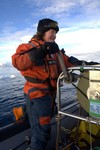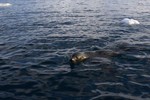Well, our midwinter celebrations are nearly over, and we’ll be back at work on Monday morning. In many ways, this is the week we’ve been looking forward to since we came South, and it hasn’t disappointed. For the last month or more people have been scurrying between the various workshops on base (the Chippy Shop, the mechanical workshop and the Sledge Store) frantically and furtively manufacturing a gift for one other lucky base member to receive on Midwinter’s Day, so Mark the carpenter and the mechanics and GAs have been busy teaching various novice craftspeople how to use saws and sewing machines and many other tools.
I ran late with my present (although not as late as some!), partly because of hurting my back sometime in May – I’m fine now – and I was concerned that my project, a wooden director’s chair, was a bit ambitious. Anyway, it was all finished and ready a day or two before the Big Day.

The week of celebrations began on Friday night, with a pub crawl. Lots of different people took it upon themselves to set up bars in different buildings around the base, so we started in the kitchen, with hotdogs, chips and Kir Royale In An Antarctic Context (cheap sparkling wine and Ribena, not nearly as bad as it sounds!) in Riet and Tim’s French-themed bar, complete with the two of them in blue stripy teeshirts, comedy moustaches and garlic necklaces. Then to my bar – the “Sky View Bar” – in the Ops Tower, with an airport lounge kind of feel – we had arrivals and departure boards and a big billboard full of adverts, including some spoof Ryanair posters (“South Pole [Sky Blu] from £0.99 one way”), and we all enjoyed a glass of G&T. After that we headed to the Sledge Store, which had its traditional Extreme Sports theme. This majored heavily on the bungee-running contest – run down the corridor and reach for the beer before being thrown backwards into the crash mats…
After that, it was on to the Bonner Lab (a scientific theme, naturally!) and then to Giants “no frills” bar, the Chippy Shop’s “World of Sport” and then the newly-refurbished Garage Office and the Met Team’s “Spirit in the Sky”, which had a novel bar carved out of a snowdrift that had formed behind an external door. Finally people staggered into the surgery, rebranded as the “Plastered Penguin” for some medic-themed drinking games.
Saturday was mostly spent recovering! Other entertainments put on during the week included a pool competition, a darts match against Bird Island (we lost) and the Rothera Midwinter Olympics – featuring slalom skiing (I was slow, but not the slowest), ice climbing and skidoo trials-riding. Midwinter’s Day itself follows a fairly traditional formula – it began with Tim (the winter Base Commander) bringing people tea and bacon butties to their rooms, and then people gradually surfaced and gathered in the dining room for a light lunch. After lunch we settled into the bar to watch The Thing, a 1982 film in which an Antarctic base (a US one, naturally) gets destroyed by a shape-shifting alien creature which kills the base staff one by one. This isn’t nearly as horrifying as it sounds, as a) the world of violent film special effects has moved on a long way since 1982 and b) the film is full of little inaccuracies that make you laugh. In particular, the fact that the base has a flamethrower (obviously!) and a big rack of rifles near the main door, and that the base commander wears a pistol with a belt full of bullets (which he uses to shoot a Norwegian pilot in the opening scene). Also, they go out in some “bad weather” which looks like a windspeed of no more than 20 knots!
After the film ended, we gathered in the bar to distribute the presents. As it happens, Soup and I were the last two people left after everyone else had drawn names from the pot, so we exchanged gifts. He received the director’s chair, and I got a rather fine hammock, made from ventile tent-fabric, which I’ll rig up on the Ops Tower balcony in the summer for those no-flying days!
Then came the Midwinter Broadcast – which is a special programme put on for BAS by the BBC, and which contains mostly messages from people’s family and friends back home. Even though we all make phone calls home, it’s still very emotional hearing your family talking to you over the crackly HF radio.
Finally we came to the main event – dinner! Riet had pulled out all the stops, and he and Mat (who was sous-chef for the day) laid on a multi-course extravaganza:
- Smoked salmon and asparagus with herby dressing
- Carpaccio of beef with parmesan shavings and granary toast
- Salmon en poupiette with tagliatelle
- Bloody Mary sorbet
- Fillet mignon with mushroom sauce, with gratin dauphinoise, cauliflower and brocolli
- Guinness ice-cream
- Coffee and cocoa cream
After all that the later part of the week was a bit subdued – we had some sea-ice training on Friday (of which more later) and then on Saturday Lowri and Tom S had organised a Murder Mystery dinner party, which had a 1960s theme. I had to be a snobbish and patronising wine critic (some might say that didn’t require any acting!) and found out that I was the murderer… shock horror!
On Sunday night we rounded off the week by skiing down the ramp by the light of torches and out-of-date distress flares, and had a barbecue on the beach, which was more successful than we’d anticipated, despite the temperature being -18.
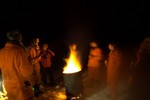
Not the Great Polar Workers Strike of ’06, but the Rothera midwinter barbecue!

